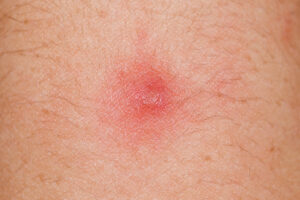Your body is constantly working to keep you protected, even if you don’t realize it. When a skin abscess forms, it’s your body’s way of trying to heal from an infection. Although they may be uncomfortable, you should be happy that your body is doing what it can to keep you healthy. That said, you should see a doctor immediately if you notice symptoms of an abscess so that the infection does not spread. In order to recognize the symptoms, you should better understand the causes and symptoms of an abscess.
What Causes a skin abscess?
Most often, skin abscesses are caused by a bacterial infection. When this happens, the immune system tries to fight the infection with white blood cells, therefore forming a puss-filled cavity called an abscess. Although this can occur anywhere on the body, it is more common in the:
- Hands and feet
- Underarms
- Back
- Face
- Chest
- Lower abdomen
This usually occurs due to bacteria getting under your skin as a result of a minor wound, such as a small cut. Some of the risk factors include: poor hygiene, exposure to dirty environments, and contact with people with certain types of infections. Additionally, there are conditions that will increase the chances of a person getting a skin abscess: weak immune system, diabetes, underlying inflammatory disease, or a chronic skin disease (such as acne or eczema).
Symptoms
There are different stages involved in the formation of a skin abscess. In the initial stages, the skin starts to appear red and swollen and begins to be painful to the touch. The skin in the affected area will also increase in temperature, while the unaffected areas will remain at their normal temperature.
The next stage usually begins 3 to 4 days after the initial symptoms. As the infected area gradually increases, pus begins to form underneath the skin. Typical symptoms include soreness and swelling, with the center of the infection turning yellow and tender.
If left untreated, the pus can be absorbed into the skin and cause:
- Weakness
- Fever
- Changes in appetite
- Nausea and vomiting
The symptoms that a person experiences will depend on how big the skin abscess is and how long it’s been left untreated.
Skin Abscesses Treatment
One mistake that many people make is trying to drain the abscess themselves, as this can push the infection deeper into the tissues. Instead, it’s recommended to see your doctor; they will ask you about your medical history, information about the abscess, if you have any allergies, and anything else that may be relevant. They will then examine the area and open or drain the abscess.
During this procedure, a local anesthesia is administered. The area is then covered with an antiseptic solution, with sterile towels placed around the abscess. The doctor then cuts it open and drains the abscess of any pus and debris. The open cavity is then washed out and packed with surgical material to help heal and prevent it from coming back. Your doctor will likely prescribe an antibiotic in order to prevent the wound from becoming infected.
Although small skin abscesses may naturally drain and heal themselves, larger ones usually require assistance from a doctor. If you notice any of the symptoms that were stated in this article, you should contact your doctor. If left untreated for too long, the inflammation and infection can spread to other parts of the body, so it’s better to get it treated as soon as you notice the symptoms.








